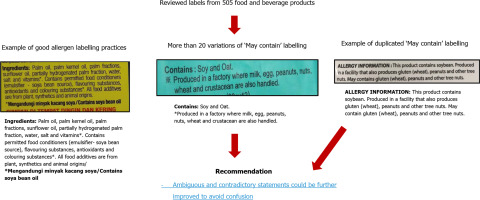Food Research International ( IF 8.1 ) Pub Date : 2018-03-31 , DOI: 10.1016/j.foodres.2018.03.068 Jan Mei Soon

|
Food allergen labelling is mandatory and regulated whilst precautionary allergen labelling (PAL) remains voluntary in most countries. It is the aim of this study to identify the food allergens declared in food products sold in a developing country and to what extent food allergens and PAL are emphasised in the products. A total of 505 food and beverages (snacks, baked goods, confectionary, baby food, condiments & jams, beverages, powder & paste, instant food, chilled & frozen food and canned food) were evaluated in Malaysia. Soybean represents the largest group of food allergen declared in labels, followed by wheat and milk products. Thirteen variations of contains statement were found with “Contains [allergen(s)]” being the most common (55.02%). There were 22 different types of “may contain” statements with ‘May contain traces of [allergen(s)]’ being the most common advice labelling used (55.41%). Different font type or emphasis such as brackets (51.57%) and bold font (33.86%) were used to inform consumers about presence of allergens. The national regulations on food allergen labelling are then critically contrasted with other Asian countries and the EU Regulation No. 1169/2011, which represents one of the most stringent food regulations in the world. Improving current allergen labelling limitations and practices would be of great benefit to consumers to prevent risk of food hypersensitivity.


























 京公网安备 11010802027423号
京公网安备 11010802027423号